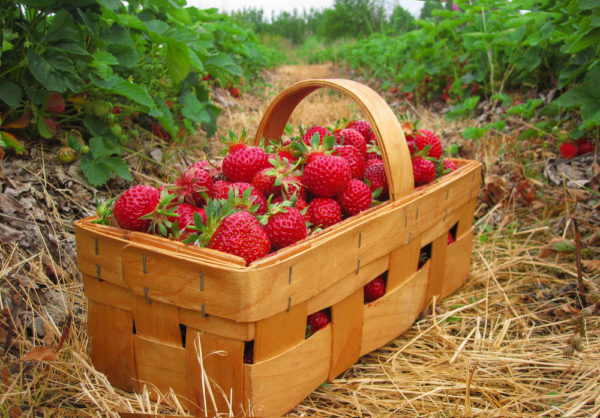Repair strawberry varieties are increasingly attracting the attention of gardeners around the world. This is due to the fact that such plants yield a crop for a long time and it is possible to feast on fresh fruits for much longer. The Evi-2 variety (sometimes called Eva), which is famous for its stability and the incredible taste of berries, has a good reputation.
Table of contents
Description of the variety of strawberry Evi-2
Let's start with the description of the berries. The variety of garden strawberry Evi-2 is a compact, sprawling bush rounded shape with an average amount of foliage light green color. The plant produces a large number of long peduncles, but the whiskers are practically absent, which makes dividing the bush the only suitable way for reproduction.
Fruiting begins in mid-June and lasts almost until the end of summer. The berries are hard, have an egg-shaped form. They are painted in a rich red color, but the core is white and pink. On average, the weight of one fruit is 15-25 grams. The flesh is firm and very dense, it tastes sweet and sour with a pleasant aroma.
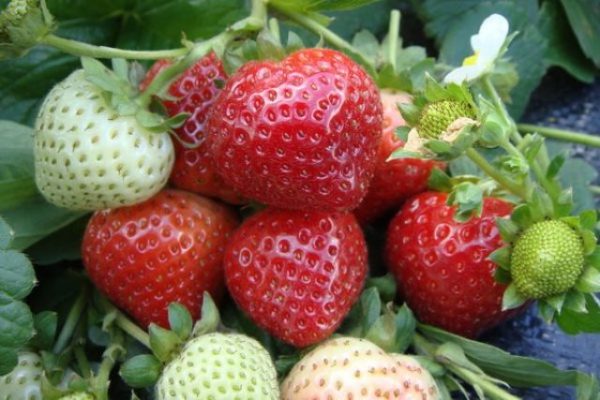
Fruits appear amicably, one large “wave”, usually, from 1 square meter of planting they collect up to 5.5 kilograms of crop. Due to its consistency, the obtained berries easily transfer transportation and can be stored in a refrigerator for up to 3 days.
Breeding history and region of growth
Garden strawberry variety Evi-2 was bred in 1998 in England, a scientist and breeder Peter Vincent. Everglade and J92D12 were used as parental varieties.
This variety perfectly tolerates all weather disasters that can be encountered in central Russia. The plant is not afraid of drought, heat, a sharp temperature drop and winter frost. Such strawberries can be grown both in the south and in the north.
To prepare the plants for the winter in the north, they are mulched and covered first with spruce branches, and then with agrofiber. In the central region it will be enough to carry out mulching and cover plantings with natural material.
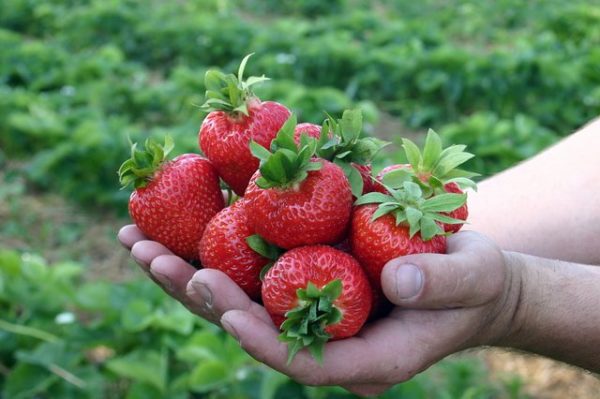
Advantages and disadvantages
Grade advantages:
- berries are very tasty and beautiful;
- the harvest is well transported and stored for a long time;
- thanks to the repair quality of the variety, fresh fruit can be obtained throughout the season;
- compactness of the bush allows you to plant more plants in a small area;
- Evi-2 is not afraid of winter frosts;
- the variety has good resistance to fungal diseases and rot.
Disadvantages:
- the flesh of such fruits is quite hard and crunches a little. It should be noted that this quality does not seem attractive to everyone;
- after heavy rains, the berries tend to crack;
- a good harvest can be achieved only with high-quality care, which includes frequent watering and top dressing;
- the absence of antennae significantly complicates the process of plant reproduction.
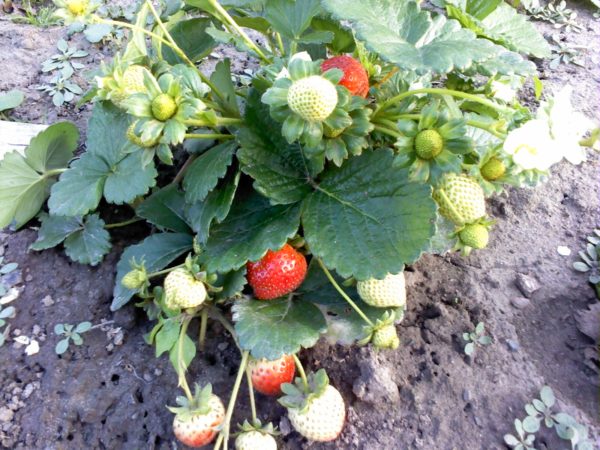
Landing rules
It is possible to plant remontant strawberries in open ground at the end of April.when the threat of recurrent frosts is over or in August. Many gardeners recommend to give preference to the spring season.
Choosing a place to grow berries, you should pay attention to the fact that they love the heat and sunlight. It is also very important to take into account which crops grew in the designated place before garden strawberries. In the best way it reacts to the soil from under the beans, garlic, dill, parsley, hyacinths and crocuses. Undesirable predecessors will be cucumbers, tomatoes, cabbage or potatoes.
Considering that Evi-2 strawberry bushes are quite compact, they are usually grown in a two-row bush method, which will also be able to protect plants from fungal infections. When using this method, the distance between the rows in one tape and between individual bushes is 25-35 centimeters. Between the tapes leave 70-80 centimeters of free space.
Before you plant the strawberries, you must add fertilizer to the soil. The following fertilizers are used per square meter:
- 1 bucket of compost or humus;
- 2 liters of vermicompost;
- 400-500 grams of wood ash.

Landing Evi-2 is as follows:
- First, dig holes, the depth and width of which will be equal to 25-30 centimeters;
- The resulting pits are filled with water and plants are placed in them;
- After the seedling will sit tight in the ground, planting is watered and mulched again with grass, needles or compost.
Further care for strawberries will be abundant, preferably drip irrigation, which will help bushes survive the hot and arid climate. It is also very important to fertilize in a timely manner, starting from April, once a month the plants are fed with organic or mineral compounds.
Breeding methods
Considering the fact that there is practically no mustache on the Evi-2 strawberry, the only vegetative method is the division of the bush. To perform such work, an adult, spreading plant is dug out of the ground and neatly divided into several parts, each of which must contain leafy sockets and well developed roots. The resulting bushes are planted in new places and looked after as individual plants.
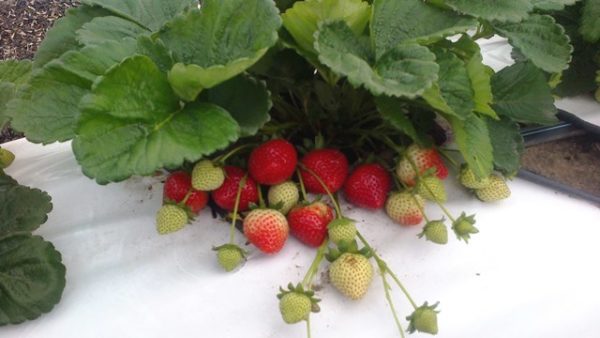
- Also, this garden strawberry can be propagated by the seed method, but it should be borne in mind that it does not give any guarantees for the preservation of varietal characteristics:
- In late February - early March, the soil is laid out in a container and spilled on top of the water;
- Then, seeds are scattered on the surface and slightly pressed into the ground;
- Landings covered with foam or glass and periodically ventilated and sprayed with a spray;
- After 3-4 weeks the shelter can be removed.
Diseases and pests
The variety of garden strawberries possesses good immunity to such common diseases,like powdery mildew and fruit rot. On the plant with the greatest probability you can find leaf spot or late blight. Among insects, slugs and snails will be the most frequent guests.
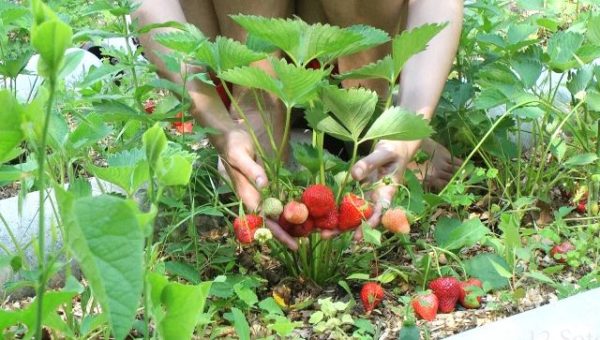
| Late blight | It is possible to get rid of a fitoftoroz by spraying of plants with Brodsky liquid, a copper sulphate or such chemical preparation as "Oksikh". |
| Leaf spot | Phytosporin, Chorus, Falcon, Ordan, etc. will be effective against leaf spotting. |
| Slugs and snails | Dry superphosphate is laid out around the plantings, and the bushes themselves are sprinkled with a mixture of tobacco dust and ash. |
As a preventive measure, it is necessary to adhere to all the rules for the care of a plant, namely to water, fertilize and remove dry foliage in a timely manner. Prophylactic treatment with Brodsky liquid or infusion of garlic will also be effective.
The variety of remontant strawberry Evi-2 can bring a rich harvest, subject to compliance with all agricultural practices. The resulting berries have a wonderful taste, tolerate transportation and are stored for a long time.
